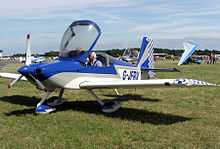Aircraft canopy

An aircraft canopy is the transparent enclosure over the cockpit of some types of aircraft. The function of the canopy is to provide a weatherproof and reasonably quiet environment for the aircraft's occupants. The canopy will be as aerodynamically shaped as possible to minimize drag.
History

Very early aircraft had no canopies at all. The pilots were exposed to the wind and weather, although most flying was done in good weather. Through World War I most aircraft had no canopy, although they often had a small windshield to deflect the prop wash and wind from hitting the pilot in the face. In the 1920s and 1930s, the increasing speed and altitude of airplanes necessitated a fully enclosed cockpit and canopies became more common.
Early canopies were made of numerous pieces of plate glass held in position by a frame and muntins. The muntins reduced visibility, which was especially problematic for military aircraft. Also, glass canopies were much heavier than acrylic canopies, which were first introduced shortly before World War II. The acrylic bubble canopy was used on aircraft such as the Supermarine Spitfire and Westland Whirlwind, which gave better all-round visibility and reduced weight.
In the 1970s, US aviation artist Keith Ferris invented a false canopy to paint on the underside of military aircraft, directly underneath the front of the plane, the purpose of which was to confuse an enemy so they do not know in what direction the aircraft is headed. This ruse was inspired by animals and fishes that have similar markings on the head and tail, so they can confuse other creatures. Pilots remain skeptical of this feature, asserting that if the enemy is close enough to see the marking, they are too close to be fooled by it.[citation needed]
Ejection seat system

On many high-performance military aircraft, the canopy is an integral part of the ejection seat system. The pilot cannot be ejected from the aircraft until the canopy is no longer in the path of the ejection seat. In most ejection seat equipped aircraft, the canopy is blown upwards and rearwards by explosive charges. The relative wind then blows the canopy away from the ejection path. However, on some aircraft, such as the AV-8B Harrier II, the pilot may be forced to eject when in a hover, or when going too slow for the relative wind to move the canopy out of the path of the ejection seat. In that situation, the pilot could possibly impact the canopy when ejecting. To overcome that possibility, some aircraft have a thin cord of plastic explosive zig-zagging across the canopy over the pilot's head. In the event of an ejection, the explosive cord is activated first, shattering the canopy. Then the ejection seat (and pilot) are launched through the shattered canopy.
Construction
Most modern acrylic canopies are vacuum formed. A sheet of acrylic is secured to a female mould, then the entire assembly is heated in an oven until the acrylic is pliable. The air is then removed from the mould and the acrylic sheet is drawn into it, forming the shape of the canopy. The acrylic is then trimmed to the appropriate shape and attached to an aluminum or composite frame. Some "one-off" canopies are made in a similar fashion, but since a mould would be too time-consuming to make, the acrylic is heated and vacuum formed until it approximates the shape the builder is seeking. This type of construction is less precise, however, and each canopy is unique. If multiple canopies will be needed, a mould is almost always used.
Gallery
-

Hawker Hurricane with canopy slid to rear
-

An A-10 Thunderbolt II with painted "false canopy" underneath the front of the plane
-

The low drag canopy of an Extra 300 aerobatic light aircraft.
-

F-16 ejection showing the canopy blown away from the aircraft by explosive charges
-

The raised canopy of an RAF Typhoon F2
-

Sukhoi PAK FA at MAKS 2011
-

Sukhoi SU-35 at MAKS 2011
References
External links
| Wikimedia Commons has media related to Aircraft canopy. |
| ||||||||||||||